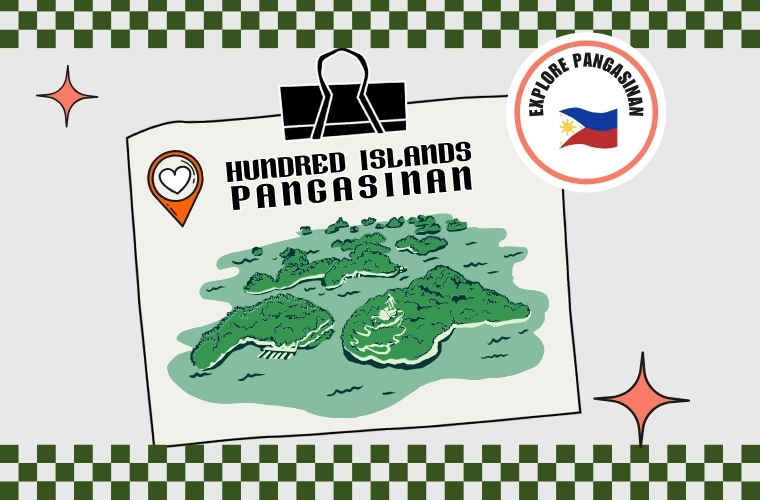
Hundred Islands National Park The Best Way To Explore
Posted in Destinations, Luzon
Introduction to Hundred Islands National Park

Hundred Islands National Park, located in Alaminos, Pangasinan, Philippines, stands as one of the most celebrated natural wonders of the country. This protected area, established in 1940, comprises 124 islands and islets during low tide and 123 during high tide, scattered over an expanse of the Lingayen Gulf. The national park spans approximately 1,844 hectares, offering a remarkable blend of ecological diversity and picturesque landscapes.
The geographical setting of Hundred Islands National Park is unique. These islands, formed millions of years ago, are believed to be ancient corals that rose from the ocean bed due to tectonic activities. The park’s terrain is predominantly characterized by karst formations, with each island varying in shape and size. Some of the most notable islands include Governor’s Island, Children’s Island, and Quezon Island, each offering distinct features and attractions.
The significance of Hundred Islands National Park extends beyond its scenic beauty. It serves as a crucial habitat for various marine and terrestrial species, making it an important ecological site. The park is home to a myriad of flora and fauna, including mangroves, coral reefs, and diverse fish species. Efforts to preserve its pristine environment have been paramount, ensuring that the natural habitat remains undisturbed by the influx of tourists.
As one of the premier tourist destinations in the Philippines, Hundred Islands National Park attracts thousands of visitors annually. The park’s allure lies not only in its natural beauty but also in the myriad of activities it offers. From island hopping and snorkeling to trekking and bird watching, the park provides a plethora of opportunities for adventure and exploration. The Hundred Islands have, over the years, become symbolic of the rich natural heritage of the Philippines, embodying the country’s commitment to conservation and sustainable tourism.
Hundred Islands: How to Get There
Reaching Hundred Islands National Park in the Philippines can be an adventure in itself due to the variety of transportation options available. The park is located in Alaminos City, Pangasinan, approximately 250 kilometers north of Manila. For travelers starting from Manila, there are several feasible routes to consider.
The nearest airport to Hundred Islands National Park is Clark International Airport in Angeles City, approximately 200 kilometers from the park. From the airport, travelers can either rent a car or take a bus to Alaminos City. For those flying into Ninoy Aquino International Airport in Manila, the journey involves a bus or car ride of around five to six hours, depending on traffic conditions.
For those opting for bus travel, several bus companies operate routes from Manila to Alaminos City. Victory Liner and Five Star Bus are two prominent operators that offer regular services. Buses bound for Alaminos usually depart from terminals located in Cubao, Pasay, or Caloocan. The bus journey typically takes around five to six hours, with fares varying depending on the type of service and amenities offered.
Driving to Hundred Islands National Park is another popular option for those who prefer the flexibility of a road trip. From Manila, travelers should take the North Luzon Expressway (NLEX) and then merge onto the Subic-Clark-Tarlac Expressway (SCTEX). From there, they can connect to the Tarlac-Pangasinan-La Union Expressway (TPLEX), exiting at Urdaneta City. Continuing on MacArthur Highway, drivers will reach Alaminos City. The entire drive from Manila to Alaminos typically takes around four to five hours, depending on traffic.
When planning a visit to Hundred Islands National Park, it is advisable to check for any necessary travel permits or preparations, especially during peak tourist seasons. Packing essentials such as water, snacks, and sun protection is recommended, as the journey can be long. Additionally, confirming accommodation in advance can ensure a smoother and more enjoyable trip.
Hundred Islands: Top Islands to Visit
Hundred Islands National Park in the Philippines is a treasure trove of picturesque islands, each offering unique experiences and attractions. Among the most notable islands are Governor’s Island, Quezon Island, and Children’s Island, each providing a distinct blend of natural beauty and recreational activities.
Governor’s Island
Governor’s Island is perhaps one of the most visited islands within the park. It is renowned for its panoramic viewpoints, offering breathtaking vistas of the surrounding seascape and neighboring islands. A short hike up to the viewing deck rewards visitors with a stunning 360-degree view, making it a perfect spot for photography enthusiasts. Additionally, Governor’s Island houses a small guesthouse, providing a rare opportunity to stay overnight in the national park. The island is also surrounded by clear waters teeming with marine life, making it an excellent location for snorkeling and swimming.
Quezon Island
Quezon Island stands out for its pristine beaches and recreational facilities. This island is named after the second President of the Philippines, Manuel L. Quezon. It is ideal for family outings and group activities, featuring picnic areas, barbecue grills, and a pavilion for gatherings. Quezon Island boasts beautiful white sand beaches where visitors can relax and soak up the sun. The island also offers exciting water sports opportunities, including kayaking and paddleboarding. For those interested in exploring underwater marvels, Quezon Island provides great snorkeling spots with vibrant coral reefs and diverse marine species.
Children’s Island
As the name suggests, Children’s Island is particularly suited for families with young children. The island features shallow, calm waters that are safe for kids to swim and play in. It is an ideal destination for a day trip, offering picnic huts and shaded areas where families can enjoy a leisurely meal. Children’s Island is also equipped with play areas and gentle walking trails, making it a haven for young explorers. The island’s serene environment and kid-friendly amenities make it a perfect spot for parents looking to introduce their children to the wonders of nature.
Each of these islands within Hundred Islands National Park offers its unique charm and activities, ensuring that visitors can find something that appeals to their interests, whether it be adventure, relaxation, or family fun.
Activities and Adventures
Hundred Islands National Park offers a myriad of activities and adventures that cater to diverse preferences and interests. Whether you are an adrenaline junkie or someone seeking a more relaxed experience, the park has something for everyone.
Water-based activities are a highlight of the Hundred Islands experience. Kayaking is particularly popular, allowing visitors to navigate the serene waters and explore the park’s numerous islets at their own pace. For those interested in underwater adventures, snorkeling and diving present opportunities to witness the vibrant marine life and intricate coral reefs. The park’s crystal-clear waters provide excellent visibility, making it a haven for underwater photographers and marine enthusiasts alike.
Island hopping is another must-do activity, offering a chance to visit some of the most iconic islands within the park, such as Governor’s Island, Quezon Island, and Children’s Island. Each island has its unique charm and attractions, from secluded beaches to scenic viewpoints.
Land-based adventures are equally enticing. The park features several hiking trails that lead to breathtaking vistas, perfect for nature lovers and photography enthusiasts. For thrill-seekers, zip-lining offers an exhilarating way to appreciate the park’s stunning landscapes from a bird’s-eye view. The zip-line at Governor’s Island, in particular, provides an adrenaline-pumping experience as you soar above the sparkling waters.
Camping is another popular option for those who wish to immerse themselves in the park’s natural beauty. With designated camping areas equipped with basic amenities, visitors can enjoy a night under the stars, surrounded by the soothing sounds of nature. Whether you prefer to relax by the beach or embark on an adventurous trek, Hundred Islands National Park promises an unforgettable experience for all.
Wildlife and Marine Life
Hundred Islands National Park, located in the Philippines, is a sanctuary of rich biodiversity, offering a home to an array of species both on land and underwater. The park’s unique ecosystem supports a variety of flora and fauna, making it a vital conservation area. Among the terrestrial inhabitants, visitors can find different birds, mammals, and reptiles, some of which are endemic to the region. The islands’ forested areas are teeming with plant life, including several species of trees, shrubs, and other vegetation that contribute to the lush landscape.
One of the most remarkable aspects of Hundred Islands National Park is its marine life. The waters surrounding the islands are a treasure trove of vibrant corals and a myriad of fish species. For snorkeling and diving enthusiasts, this underwater paradise offers an unforgettable experience. Divers can encounter colorful coral reefs, schools of fish darting through the water, and occasionally, the majestic sea turtles that glide gracefully through the currents. These marine ecosystems are not only stunning to observe but also play a crucial role in maintaining the health of the ocean environment.
Moreover, the park is home to several endangered species, underscoring the importance of ongoing conservation efforts. The protection of these species is paramount to preserving the park’s ecological balance and ensuring that future generations can continue to enjoy its natural beauty. Conservation programs are in place to monitor and safeguard the habitats of these vulnerable species, highlighting the commitment to maintaining the park’s biodiversity.
In essence, Hundred Islands National Park is a haven for wildlife and marine life, offering a glimpse into the Philippines‘ rich natural heritage. Whether exploring the islands’ lush terrain or diving into its vibrant waters, visitors are sure to be captivated by the incredible diversity and splendor of this national treasure.
Best Time to Visit
Hundred Islands National Park, located in the Philippines, boasts a tropical climate characterized by two distinct seasons: the dry season and the wet or monsoon season. Understanding the weather patterns is crucial for planning an enjoyable trip. The best time to visit the park is during the dry season, which typically extends from November to April. During these months, the weather is generally sunny and pleasant, ideal for outdoor activities such as island hopping, snorkeling, and swimming.
The dry season offers calm seas and clearer skies, enhancing visibility for underwater adventures. January to March are particularly favored months, as temperatures remain moderate, avoiding the scorching heat of the summer that starts in April. This period is also peak tourist season, meaning the park can be busier, and accommodations may require advance bookings. However, the vibrant atmosphere and organized tours make it a worthwhile experience.
The monsoon season, from May to October, brings heavy rainfall and occasional typhoons. Traveling during this period can be challenging due to unpredictable weather and rough sea conditions, making some islands inaccessible. However, for those who prefer a quieter experience and are willing to take a risk with the weather, visiting during the off-peak season can offer solitude and lower travel costs. Just be sure to check weather forecasts and prepare for possible changes in travel plans.
The shoulder months of May and November can be a good compromise, as they mark the transition between seasons. During these months, the weather can be less predictable, but there are still opportunities for decent weather and fewer crowds. Planning a trip to Hundred Islands National Park requires careful consideration of these seasonal variations to ensure a safe and enjoyable visit.
Accommodation and Dining Options
When planning a visit to Hundred Islands National Park, visitors will find a variety of accommodation options to suit different preferences and budgets. For those seeking budget-friendly options, there are several hostels and guesthouses located in Alaminos City, the main gateway to the park. These establishments offer basic amenities and easy access to transportation hubs leading to the islands.
For a more comfortable stay, mid-range hotels and inns provide additional conveniences such as air conditioning, private bathrooms, and complimentary breakfast. Many of these accommodations also offer packages that include boat transfers to the islands, making it easier for travelers to organize their trip.
For those looking for a luxurious experience, there are upscale resorts and boutique hotels situated closer to the coastline. These resorts often feature stunning sea views, private beaches, and a range of recreational activities such as snorkeling, kayaking, and island-hopping tours. Some resorts even offer spa services and fine dining restaurants, ensuring a relaxing and indulgent stay.
Unique lodging experiences are also available within the park itself. Adventurous visitors can opt to stay in a houseboat, providing a unique perspective of waking up surrounded by clear waters and picturesque islands. Alternatively, camping is permitted on select islands, allowing nature enthusiasts to experience the beauty of Hundred Islands National Park up close. Campers should bring their own gear and be prepared for a more rustic experience, as facilities are limited.
When it comes to dining, visitors will find a variety of options to satisfy their appetites. Local restaurants and food stalls in Alaminos City offer an array of Filipino dishes, including seafood specialties such as grilled fish, shrimp, and squid. Must-try dishes include “bangus” (milkfish), “adobo” (marinated meat stew), and “halo-halo,” a popular Filipino dessert made of mixed fruits, shaved ice, and sweetened beans. Dining within the park itself may be limited, so it is advisable to bring snacks and water during island excursions.
Whether seeking budget accommodations or luxurious retreats, visitors to Hundred Islands National Park will find a range of options to enhance their stay. Dining experiences, rich with local flavors, further enrich the journey, making it a destination that caters to diverse tastes and preferences.
Travel Tips and Safety
Planning a trip to Hundred Islands National Park in the Philippines requires some preparation to ensure a safe and enjoyable experience. One of the most important aspects is packing appropriately. Given the tropical climate, it is advisable to bring lightweight, breathable clothing, sunscreen, hats, and sunglasses to protect against the sun. Additionally, packing swimwear, water shoes, and waterproof bags can be beneficial for island hopping and water activities.
Health and safety precautions are essential. It is recommended to carry a basic first aid kit, including antiseptic wipes, band-aids, and any personal medications. Staying hydrated is crucial, so bring plenty of water or a reusable water bottle. Insect repellent is also a must to protect against mosquitoes, especially during the wet season. Travelers should be aware of any necessary vaccinations or health advisories before embarking on their journey.
Environmental conservation practices are highly encouraged within Hundred Islands National Park. Visitors should adhere to the “Leave No Trace” principles by taking all their trash with them and avoiding any activities that could harm the local flora and fauna. It is important to respect designated areas and not disturb the natural habitat. Supporting local conservation efforts, such as participating in clean-up drives or following sustainable tourism practices, can also contribute to the preservation of this natural wonder.
Understanding local customs and etiquette can enhance the travel experience. Filipino culture is known for its hospitality and friendliness, so reciprocating with respect and politeness is appreciated. Visitors should dress modestly when not at the beach and be mindful of local sensitivities, especially in religious or cultural sites. Tipping is customary in restaurants and for other services, typically around 10% of the bill.
Lastly, visitors should be aware of the rules and regulations within Hundred Islands National Park. It is important to stay within designated areas, follow the guidance of park rangers, and adhere to safety warnings, especially regarding swimming and diving spots. By being prepared and respectful, travelers can ensure a memorable and safe visit to this breathtaking national park.

Go Explore Philippines
Welcome to GoExplorePhilippines.com, your go-to guide for exploring the Philippines. Discover tips, travel guides, and stories about the stunning landscapes, vibrant culture, and delicious cuisine of Luzon, Visayas, Mindanao, and beyond. Join us on an adventure to uncover the hidden gems of the Philippines!











